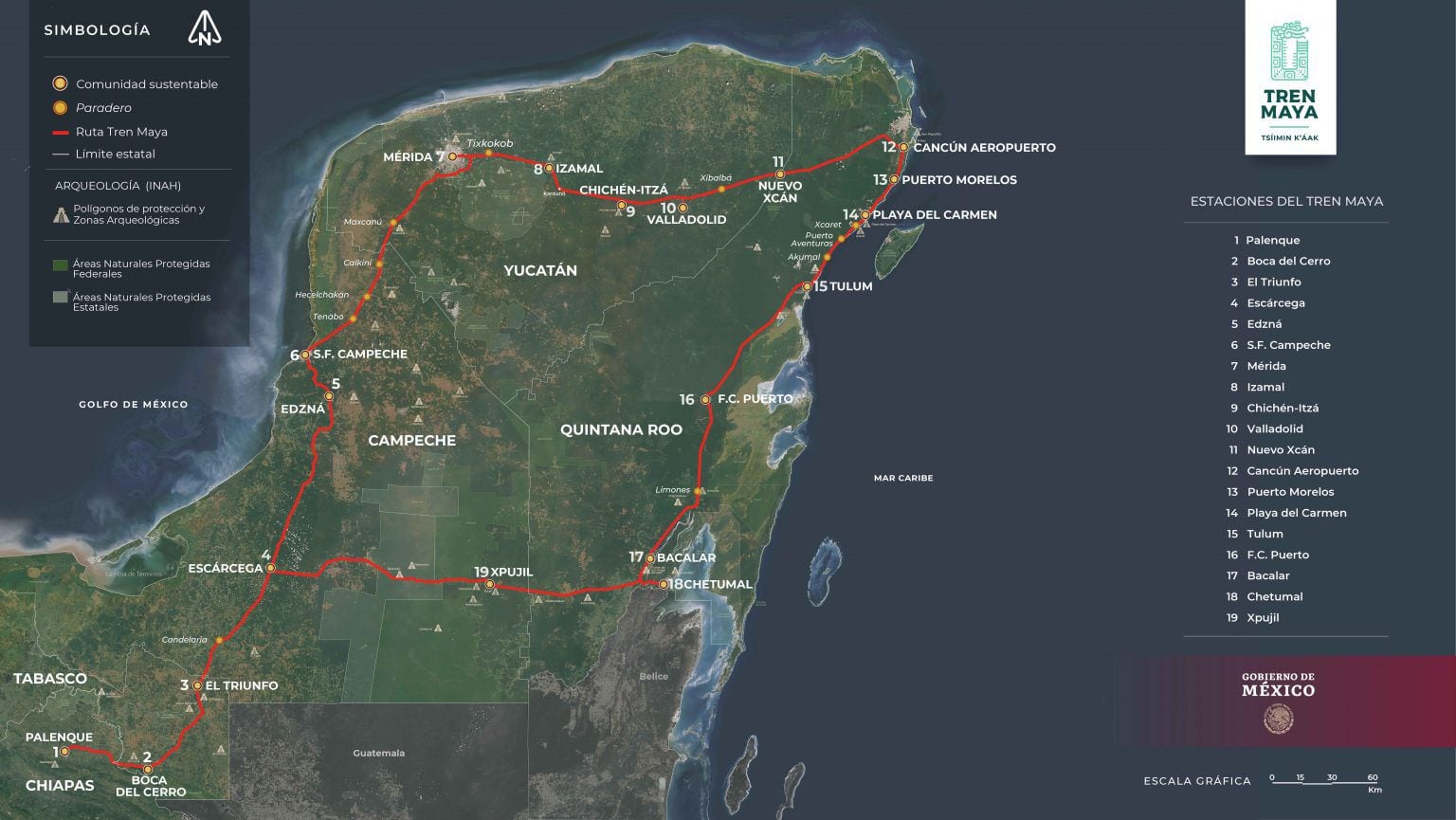
Despite its progress, the construction of the Maya Train has encountered a number of setbacks since it was announced by President Andrés Manuel López Obrador. On this occasion, a possible sinkhole was detected in the area where the works are being carried out for Section 5.
And it is that on March 28, a group of Green Peace activists demonstrated against this mega-project, chaining themselves to the machinery in the area of that stretch, which runs from Playa del Carmen and reaches Tulum, with an extension of approximately 60.3 kilometers.
In this area there is an underground cavern known as “Angry Wasp”, which covers 3,278 meters in length where the Mayan Train will pass and where personnel from the National Institute of Anthropology and History (INAH) work to find signs of human remains.
For this reason, several NGOs have spoken out against its construction, claiming that it is not only this cavern, but also other caves and cenotes that would be affected by the passage of the Mayan Train, although AMLO has reiterated that its flagship project will not affect the cenotes or the ecosystem of the region.

According to Green Peace, this stretch would pass through several underground rivers and cave systems, where the Dos Ojos-Sac Actun system is located, which covers up to a thousand kilometers and where about 200 archaeological sites can be found.
However, they had previously been warned of the presence of sinkholes in Section 5, so they had to make a change in their construction. Initially, it was planned to be installed on an elevated section parallel to federal highway 307 Playa del Carmen-Tulum, but due to the disagreement of the hoteliers, it was decided to build it at ground level.
With this change, Section 5 would be located seven kilometers inside the jungle zone parallel to the federal roads. This is in addition to the fact that, so far, there is no environmental impact study due to the construction of Section 5.

Luisa Falcón, researcher at the Institute of Ecology of the Autonomous University of Mexico (UNAM), pointed out that there must be a project on the possible risks of this mega-project, since taking into account the magnitude of its construction, a study should be carried out on land use and the ecological consequences for inhabitants of the area.
“Speaking of this section 5, it is evident the presence of these large sinkholes (which are actually entrances to caves and caves). This region is very fragile,” he commented at the Mayan Train Forum: analysis of impacts from academia, organized by the University Seminar on Society, Environment and Institutions (SUSMAI).
For her part, Ana Esther Ceceña, researcher from the Institute of Economic Research of the UNAM, mentioned that among the main problems in the construction of Section 5 are: fauna passes, calculation of the route, karst soil and the impact of the Cenotes Ring.
In addition, he recalled that the speed at which the Maya Train will run is 160 kilometers per hour, on porous and brittle soil, so that the terrain, over time, could sink, together with the increase in visitors in the Calakmul area, which would increase from 40,000 to 3 million.

On January 20, 2021, the Assembly of Defenders of the Mayan Territory Muuch' Xíinbal presented an amparo for violations of their environmental rights, as well as their rights as an original Mayan people, since the construction of the Maya Train would possibly affect their territory and natural resources.
In this regard, the Fourth District Court instructed the Ministry of Environment and Natural Resources (Semarnat), through the General Directorate of Environmental Impact and Risk (DGIRA), to terminate the Environmental Impact Manifestation (MIA) in its regional modality, and the works in phase 1 were paralyzed. However, in April 2021, the National Fund for the Promotion of Tourism (Fonatur) and Semarnat challenged this resolution.
While the Court chose to deny the suspension of the Mayan Train, Semarnat's appeal indicated the suspension of the works. Thus, there were two resolutions that contradicted each other, so Fonatur submitted a request to clarify this case.
On March 25, 2022, the Collegiate Court reiterated its decision and reported on the refusal to suspend the president's megaproject, so that works on the Maya Train could continue. However, the Múuch' Xíinbal Assembly pointed out that “with this decision, the Court fell into a serious contradiction in the trial, leaving the plaintiffs uncertain, who do not know whether the protective measures continue or cease”.
KEEP READING:
Últimas Noticias
Debanhi Escobar: they secured the motel where she was found lifeless in a cistern
Members of the Specialized Prosecutor's Office in Nuevo León secured the Nueva Castilla Motel as part of the investigations into the case

The oldest person in the world died at the age of 119
Kane Tanaka lived in Japan. She was born six months earlier than George Orwell, the same year that the Wright brothers first flew, and Marie Curie became the first woman to win a Nobel Prize

Macabre find in CDMX: they left a body bagged and tied in a taxi
The body was left in the back seats of the car. It was covered with black bags and tied with industrial tape
The eagles of America will face Manchester City in a duel of legends. Here are the details
The top Mexican football champion will play a match with Pep Guardiola's squad in the Lone Star Cup

Why is it good to bring dogs out to know the world when they are puppies
A so-called protection against the spread of diseases threatens the integral development of dogs




